Abstract
Precambrian shields and outcropped Precambrian rock complexes in the Arctic may serve as the most important sources of various types of mineral raw materials, including gold. The gold potential of the Anabar shield in the territory of Siberia has, thus far, been poorly studied. A number of primary and placer gold occurrences have been discovered there, but criteria for the prediction of and search for gold mineralization remain unclear. The main purpose of this paper was to study the typomorphic features of placer gold in the central part of the Billyakh tectonic mélange zone in the Anabar shield and to compare them to mineralization from primary sources. To achieve this, we utilized common methods for mineralogical, petrographic, and mineragraphic analyses. Additionally, geochemical data were used. As a result of this investigation, important prospecting guides were identified, and essential criteria for the prediction of and search for gold deposits were elucidated. The characteristics of the studied placer gold were specific for gold derived from a proximal provenance. These characteristics included the poor roundness of the native gold grains, a cloddy–angular and dendritic form, an uneven surface, and a high content of coarse-fraction native gold (0.5–2 mm), which was as high as 24% of the volume of analyzed native gold. In addition, we conducted a study on the mineralogical features of the gold-sulfide mineralization that was disseminated throughout a small exposure area of paleo-Proterozoic para- and orthogneisses in the Anabar shield basement. A comparison of mineral inclusions in the coarse-fraction native gold and mineral assemblages in the ore deposits showed that one of the possible primary sources for placer gold might be small bodies of metasomatically altered orthogneisses associated with large granitoid plutons.
1. Introduction
The Anabar shield is a major element of the Arctic tectono-mineragenic belt. Despite the fact that most large and superlarge deposits of precious, radioactive, and rare-earth metals around the world are concentrated within shields, no economically important gold deposits have yet been discovered in the Anabar shield. Meanwhile, the method of studying the evolution of minerals in placers can help to identify their potential ore bodies [1,2]. Additionally, the study of the complex of placer gold typomorphic features is a highly effective way of predicting processes of gold mineralization on territories covered by Quaternary deposits, including the studied shield. The complex of placer gold typomorphic features (grain sizing, morphology, chemical composition, and mineral micro-inclusions) can be used as a means of exploration and evaluation throughout all stages of geological prospecting [3]. The grain-size composition of placer gold is characterized by gold long-range transfer from ore bodies. Gold from short-range transfers has a larger dimensionality, which decreases with further transfer from the ores [4]. Ore gold normally tends to have a tubercular, pitted, and dimpled surface. When the roundness ratio increases, the primary tubercular and dimpled surface is lost in the placers, as well as its angles. Resulting from its long-term presence in the hydrodynamic environment, the morphology of gold undergoes major changes by crushing, rolling, and abrasion [1,5]. Native gold fineness in deposits of different depths and formation types has large variations of data, resulting from the impact of multiple factors within ore deposits. Fineness dispersion tends to increase in deposits with unstable environments of shallow depths and to decrease in deposits with stable environments of mid and deep depths [6]. The fineness of the placer gold core corresponds to the fineness of the ore bodies [6]. Substantially, the average fineness increases with the ablation range and its rolling extent growth, which is also due to formation of a fine corrosive sheath in the crust of weathering [4,7].
Mineral micro-inclusions preserved in the core of placer gold are essential indicators that characterize the mineral type of its ore body [3]. The detailed study of these inclusions is particularly reverent for potential gold-bearing regions, where gold deposits are yet to be found.
Presently, two potential gold-bearing placer manifestations (Borosku Unguokhtakh and Ulakhan Khaptasynnak creeks) have been identified in the north-east of the Anabar shield, where search and evaluation work is in progress. In order to predict gold ore bodies, we studied the placer gold typomorphic features from these manifestations. Additionally, in order to achieve our goal, we studied the mineralogical and petrographic features of the disseminated gold-sulfide mineralization, which was first discovered by us in the small area of the foundation exposure in the central part of the Billyakh tectonic melange zone of the Anabar shield (Borosku Unguokhtakh and Ulakhan Khaptasynnak upper reaches).
The issue of gold potential in the Anabar shield and its environs has received little attention from researchers in the past. According to Rabkin [8], the primary sources of gold in the Anabar massif are sulfidized gneisses located in the mineralized crushed zones of the Archean age. According to Shpount [9], placer gold mineralization was partly formed through the erosion of Precambrian sulfidized quartz–calcite veins hosted in basites. He also proposed that the most likely intermediate gold collectors in the eastern part of the Anabar shield were gritstones and conglomerates of the Billyakh series from the Riphean age. In the southeastern part of the Anabar massif, Levin and Permyakov [10] identified gold–antimony mineralization overlying the rocks of the Middle Proterozoic Mukun Formation along tectonic dislocation zones. Tolstov [11,12] proposed that the sources of high-fineness placer gold in the eastern portion of the Anabar shield are quartz or sulfide–quartz veins. As indicated in a monograph by Dodin [13], previous researchers have identified gold ore fields with low-sulfide gold–quartz and gold–quartz formations in the northern Anabar shield, and have linked them to the Kieng–Kyllakh gold zone: the content of gold in the pyritized quartz veins was 0.2–0.3 ppm. Smelov and coauthors [14] have predicted the presence of copper–porphyry Au, Cu, Mo, and Ag deposits, both inside and nearby the outcropped massifs of igneous rocks (diorite–granodiorite–monzonite sodic–potassic, and diorite–granodiorite–granite potassic formations) in the Kotuykan–Monkholo and Billyakh tectonic–mélange zones of the Anabar shield. According to Kuznetsov [15], the main metallogenic feature of the Anabar shield is the presence of complex Anabar-type Cu–Mo–U–Au mineralization analogous to the unique Olympic Dam deposit in southeastern Australia [16].
Results from analyses of structural–formational and regional metallogenic and geochemical data that are available for the Anabar shield have led previous researchers to conclude that most magmatic rock complexes with potential precious metal mineralization are located within the Kotuykan and Billyakh tectonic mélange zones, and include the identification of the Billyakh (Au, Cu, Mo, and REE specialization) and Kotuykan–Monkholo (Pt and Au specialization) metallogenic zones [11,14,17]. However, no primary and placer gold deposits have been discovered, to date, in the study area.
2. Materials and Methods
The grains of native gold were extracted from small-volume (1 m3) samples taken from alluvial sediments in the upper reaches of the Borosku Unguokhtakh and Ulakhan Khaptasynnakh creeks. Sampling locations are shown in Figure 1. The alluvial material was subjected to panning in a “Siberian” wash pan, and small-volume samples (1 m3) were screened through a trommel. A detailed analysis of the morphology and surface relief was conducted based on photographs of native gold particles that were obtained with a JEOL JSM-6480LV scanning microscope (JEOL, Ltd., Tokyo, Japan). Native gold fineness (Au, Ag, Hg, and Cu) was determined on a CAMECA Camebax-Micro microanalyzer (CAMECA, Gennevilliers, France) (accelerating voltage 20 kV, probe current 30 nA, and measurement time 7 s). Limits of element detection (in wt.%) were as follows: Au, 0.117; Ag, 0.061; Hg, 0.083; and Cu, 0.031. The fineness of one gold grain was identified by three points of the polished shear: central, lower, and upper marginal parts. More than 500 identifications of gold fineness were conducted. The gradation of the particle sizes and gold fineness was given in the classification of [4]. Eight samples of sulfidized igneous rocks were selected on the watershed of the Borosku Unguokhtakh and and Ulakhan Khaptasynnakh creeks. Atomic absorption, semiquantitative spectral, and wet chemistry analyses were conducted in the Diamond and Precious Metal Geology Institute by the specialists of Physical and Chemical Methods of Analysis Department. Analyses of mineral inclusions in the placer gold and the gold-sulfide disseminations were conducted on polished thin sections using a JSM-6480LV microscope equipped with Oxford Instruments wavelength and energy-dispersion spectrometers (accelerating voltage 20 kV, probe current 1.09 nA, and measurement time 7 s). The analytical lines were Au–Mα, Ag–α, and other elements–Kα. The standards were gold 850‰–Au, Ag; FeS2 (pirite)–Fe, S; СuFeS2 (chalcopyrite)–Cu; FeAsS (arsenopyrite)–As; ZnS (sphalerite)–Zn; Са5[PO4]3(F) (fluorapatite)–Ca, P, F; Na[AlSi3O8] (albite) – Na, Al, Si; K[AlSi3O8] (ortoclase)–K; CeO2 (cerianite)–Ce. Limits of element detection (in wt. %): Au 1.81, Ag 1.11, Fe 1.02, S 0.71, Cu 1.22, As 1.07, Zn 1.73, Ca 0.62, F 0.92, P 0.44, Na 0.44, Al 0.36, Si 0.57, K 0.45, Ce 1.68. The analysis was performed by N. Khristoforova.
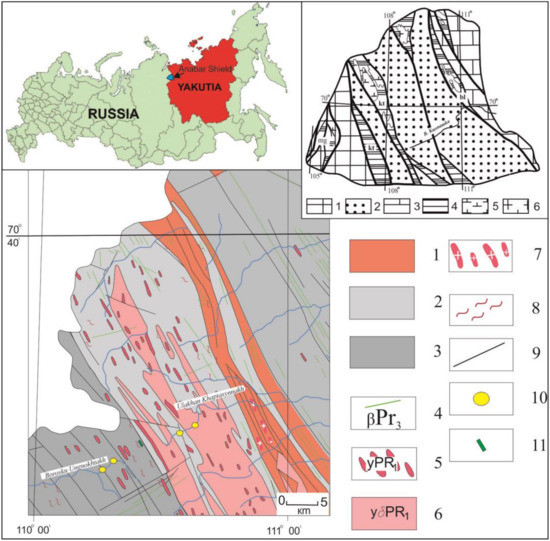
Figure 1.
Schematic geological map of the Billyakh zone. 1–3: Precambrian metamorphic complexes (series). 1: Khaptasynnakh (garnet, clinopyroxene, hypersthene–garnet, hypersthene, bipyroxene plagiogneisses, biotite–graphite-bearing varieties of these rocks, calciphyres, marbles, rare beds of sillimanite gneisses, and basic schists) and Billyakh–Tamakh (garnet, hypersthene–garnet plagiogneisses, and sometimes biotite or graphite-bearing) sequences of the Khapchan series, undifferentiated; 2: Upper Anabar series (hypersthene, bipyroxene, and hornblende–bipyroxene plagiogneisses and gneisses; pyroxene–plagioclase and hornblende–pyroxene–plagioclase schists; rare bands of salite and garnet plagiogneisses); 3: Undifferentiated metamorphic complexes of the Central Anabar (Daldyn terrane) and East Anabar (Khapchan terrane) geoblocks; 4–7: Intrusive rocks. 4: Meso and Neoproterozoic diabases and gabbro-diabases (β-PR3); 5: Paleoproterozoic alaskite and leucocratic granites (γ1-PR1); 6: Paleoproterozoic porphyry biotite–hornblende granodiorites, monzonites, granites, and granosyenites (γ-ẟPR1); 7: Paleoproterozoic diorite–syenites, syenites, and granosyenites; 8: Migmatization and granitization zones; 9: Tectonic contacts; 10: Location of small-volume (1 m3) samples; 11: Zone of sulfidized magmatic rocks. The inset map shows the tectonic structure of the Anabar shield: 1–3: Geoblocks; 1: Magan; 2: Daldyn; 3: Khapchan; 4: Tectonic mélange zones (mg: Magan; kt: Kotuykan; bl: Billyakh).
3. Results
3.1. Geological–Structural Setting of the Study Area
The study area covered the central part of the Billyakh tectonic mélange zone (TMZ) (Figure 1), which extends northwest for 250 km and is 30 km wide. This zone and other linear zones divide the Anabar shield into a series of granulitic block-terranes [18,19]. The Billyakh TMZ was formed by a system of closely spaced faults containing traces of blastomylonites and cataclasites, with variably diaphthorized granulites of the Upper Anabar and Khapchan Series between them (Figure 1). In the central part of the Billyakh zone, the rocks of both series are punctuated with a large Billyakh pluton of porphyroblastic granodiorites and granites [8,18], as well as by small bodies and dikes of biotite–hornblende gneisses with amphibolite facies (which include chemical analogues of quartz monzodiorites, granosyenites, and moderately alkaline granites with which potential Au mineralization is thought to be associated) [14,20]. The sampling site covered the upper reaches of the Borosku Unguokhtakh and Ulakhan Khaptasynnakh creeks and the interstream area (Figure 1).
3.2. Typomorphism of Placer Gold
We studied the mineralogical–geochemical features of placer gold extracted from small-volume (1 m3) samples taken from alluvial sediments in the upper reaches of the Borosku Unguokhtakh and Ulakhan Khaptasynnakh creeks (Figure 1). See Section 2 for the research methodology.
In the Borosku Unguokhtaakh area, we studied more than 2000 native gold grains with a total weight of 5.425 g. The granulometric composition was +1 mm (10%), 0.5–1 mm (25%), 0.25–0.5 mm (42%), and <0.25 mm (23%). The native gold was tabular, cloddy–angular or wiry in form, and poorly rounded (Figure 2).
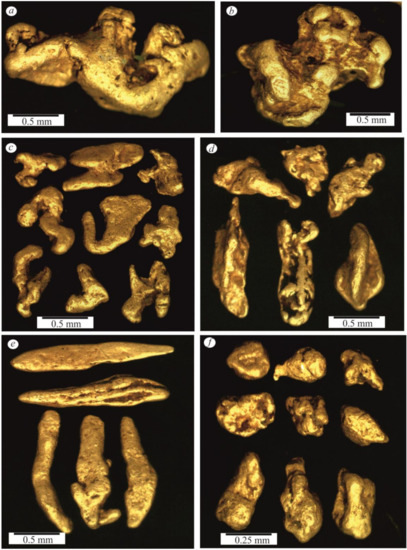
Figure 2.
Morphology of native gold from the Borosku Unguokhtakh Creek: (a,b) ore-like, fractions of +1 mm; (c) poorly rounded, fractions of 0.5–1 mm; (d) cloddy–angular, elongated dendritic, fractions of 0.5–1 mm; (e) wiry, fractions of 0.5–1 mm; (f) cloddy, cloddy–angular, fractions of 0.25–0.5 mm. Photographed by a Color Digital Camera Levenhuk C800 NG microscope (Levenhuk, Inc., Tampa, FL, USA)
The native gold fineness varied widely: 951‰–999‰ (75%), 900‰–950‰ (10%), 800‰–899‰ (3%), 700‰–799‰ (5%), and 699‰–400‰ (7%). Impure elements included Ag (up to 54.76 wt.%), Cu (up to 2.28 wt.%), and Hg (2.31 wt.%). X-ray spectral analysis revealed that there were micro-inclusions of the sulfides pyrrhotite, pyrite, chalcopyrite, sphalerite, and arsenopyrite. Hessite, quartz, K-feldspar, and Fe-, Ti-, and Al-bearing phases were also found (Figure 3).
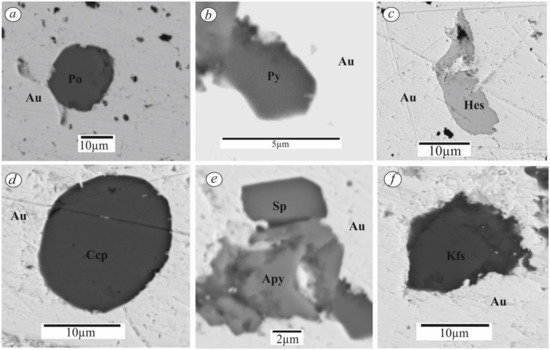
Figure 3.
Mineral inclusions in the placer gold from the Borosku Unguokhtakh Creek: (a) a rounded pyrrhotite (Po) grain; (b) a small pyrite (Py) crystal; (c) an irregularly shaped hessite (Hes) grain; (d) an oval chalcopyrite (Ccp) grain; (e) sphalerite (Sp) and arsenopyrite (Apy) intergrowth; (f) K-feldspar (Kfs). Images have been taken in BSE mode. Conventional symbols of minerals have been taken from [21,22].
In the area of the Ulakhan Khaptasynnakh Creek, native gold particles with a total weight of 7 g were studied (more than 3000 grains of native gold). The granulometric composition was 1–2 mm (7%), 0.5–1 mm (5%), 0.25–0.5 mm (30%), and −0.25 + 0.1 mm (58%). The particles were poorly rounded, cloddy–angular, and dendritic, with a pitted surface (Figure 4). Individual crystals intergrown with quartz or a fragmentary shell of aluminosilicate were often observed. The native gold fineness was extra high (951‰–999‰, 48%), high (900‰–950‰, 10%), moderate (800‰–899‰, 10%), relatively low (700‰–799‰, 10%), and low (699‰–400‰, 22%). Ag (up to 52–45 wt.%), Cu (up to 1.25 wt.%), and Hg (1.28 wt.%) impurities also appeared. Large native gold particles (fractions of +1 mm) contained mineral inclusions of pyrrhotite, pyrite, chalcopyrite, and monazite (Figure 5).
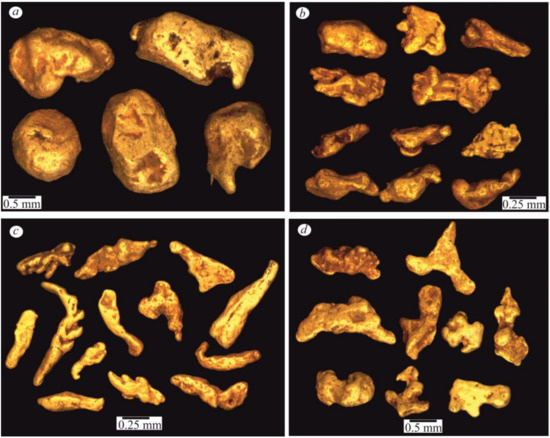
Figure 4.
Morphology of placer gold from the Ulakhan Khaptasynnakh Creek: (a) subrounded crystals, fractions of 0.5–1 mm; (b) poorly rounded cloddy–angular gold, fractions of 0.25–0.5 mm; (c) dendritic gold particles, fractions of 0.25–0.5 mm; (d) poorly rounded platy gold. Photographed by a Color Digital Camera Levenhuk C800 NG microscope.
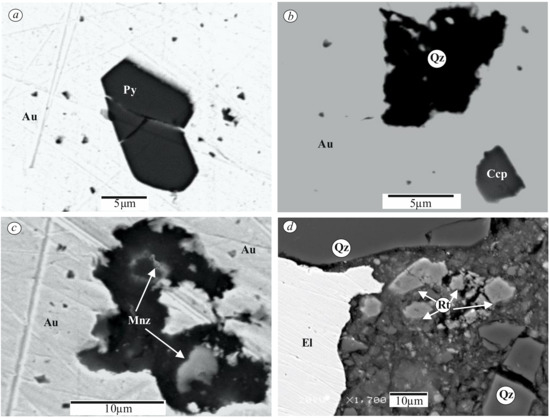
Figure 5.
Mineral inclusions in placer gold from the Ulakhan Khaptasynnakh Creek: (a) pyrite (Py) crystal; (b) quartz (Qz) and chalcopyrite (Ccp) inclusions; (c) small monazite (Mnz) crystals; (d) rutile (Rt) and quartz (Qz) grains in electrum. Images have been taken in BSE mode. Conventional symbols of minerals have been taken from [21,22].
It was discovered that the fineness of native gold does not depend on the grain size. Differences in fineness can probably be explained by unstable physical and chemical conditions of its deposition. Copper and mercury are found in native gold as an impurity, not as mineral inclusions.
It should be noted that a small gold nugget was found in this area. It was 11 mm in length, 7 mm in width, and 3 mm thick. The nugget had a platy form, a pitted surface, and was poorly rounded (Figure 6). Its weight was about 0.48 g. The chemical composition of the native gold was uniform, and the fineness varied within a narrow range of 539‰ to 589‰. A high fineness shell associated with exogenic processes [4] was barely observed (Figure 6). There were also inclusions of pyrrhotite, rutile, pseudorutile, quartz, kaolinite, and Fe-, Ti-, and Al-bearing phases.
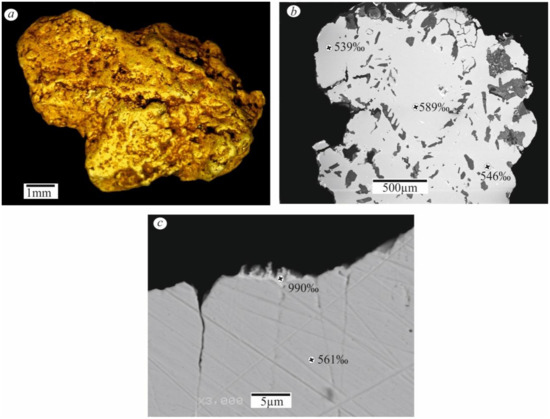
Figure 6.
Characteristics of an unrounded mininugget of gold: (a) general view; (b) variations in fineness; (c) a thin and discontinuous high-fineness shell in an initial stage of generation at the periphery of the nugget. Photographed by a Color Digital Camera Levenhuk C800 NG microscope.
Therefore, the poor roundness and uneven surface of the mininugget and the relatively coarse gold particles (fractions of 0.5–2 mm) indicate that this placer gold was autochthonous and had a proximal bedrock source.
3.3. Mineralogical Features of the Disseminated Mineralization
In the divide between the Ulakhan Khaptasynnakh and Borosku Unguokhtakh creeks (in the distribution area of the Precambrian metamorphic rocks west of the Billyakh pluton), we identified a small zone of sulfidized igneous rocks traceable over a 300 m distance (Figure 1). The rocks had a massive texture and a gray or pinkish-grey color when they were freshly sheared. The color of their surfaces was brown, which was likely due to the decomposition of sulfides. Eight samples were collected at intervals of 30–50 m. An X-ray spectral analysis showed the presence of sulfide minerals, such as pyrrhotite, pyrite, and chalcopyrite (Figure 7). A small native gold particle was found near quartz and chalcopyrite. Hessite also occurred as very fine streaks along the boundaries of the intergrown pyrite and chalcopyrite. Small and almost isometric crystals of monazite were also found. Minute galena grains were rarely observed. Atomic absorption analysis showed that the gold content in rocks was up to 2.8 ppm.

Figure 7.
Disseminated ore mineralization in the alkali feldspar syenites: (a) pyrite (Py) in a plagioclase (Pl)–K-feldspar (Kfs) substratum; (b) a chalcopyrite (Ccp) grain; (c) a small native gold (Au) grain with quartz (Qz) and chalcopyrite (Ccp); (d) a hessite (Hes) streak within chalcopyrite (Ccp) and pyrite (Py) intergrowth; (e) a monazite (Mnz) grain; (f) pyrrhotite (Po) grains in a K-feldspar (Kfs) substratum. Images have been taken in BSE mode. Conventional symbols of minerals have been taken from [21,22].
From the information given above, it follows that the parageneses of the ore minerals in the sulfidized rocks were comparable to the mineral inclusions in the placer gold from the Borosku Unguokhtakh and Ulakhan Khaptasynnakh creeks. This suggests that these rocks may be the source of the placer gold discussed here.
3.4. Petrochemistry of Ore-Hosting Rocks
The chemical compositions of sulfidized rocks are given in Table 1, and figurative composition points are shown in Figure 8, together with datapoints for the Billyakh pluton and dike complex (these datapoints were obtained by previous investigators).

Table 1.
Chemical compositions of the sulfidized rocks (in wt.%).
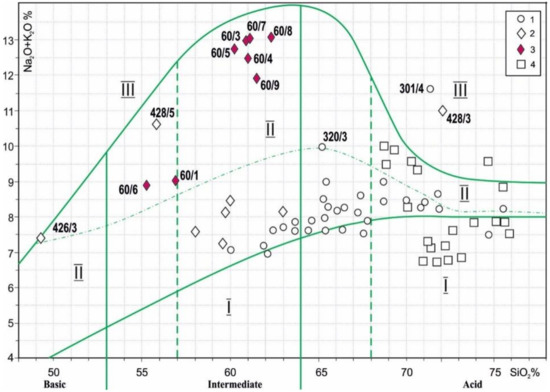
Figure 8.
SiO2 and Na2O + K2O ratios in the rocks of the Billyakh pluton and the dikes on a simplified classification diagram. Vertical lines divide the basic, intermediate, and acidic rocks, and their subdivisions are shown by dashed lines. The curved lines divide the rocks into fields by alkalinity, where I is normal, II is moderately alkaline, and III is alkaline, and the dashed line shows subdivisions in the moderately alkaline rocks. The figurative points of analyses were recalculated to 100%, without considering the volatile components (1–4). 1—Billyakh pluton samples; 2—dike complex samples; 3—samples from Table 1; 4— granitoids samples. Analyses were conducted using samples from the collections of A.P. Smelov and B.B. Gerasimov, and data from [8,20] were also used. The samples from Table 1 and some samples from A.P. Smelov mentioned in the text are numbered.
The datapoints for the Billyakh pluton rocks revealed a pronounced trend in the lower part of the field of moderately alkaline rocks (quartz monzodiorites, granosyenites, and granites), with rare, smooth transitions into the field of normal-alkalinity rocks. Two samples strongly deviated from the trend toward a more alkaline field due to elevated and high K2O contents: granosyenite 320/3 with K2O = 6.2%, and alkali granite 301/4 with K2O = 10.5%. In many papers, the predominant rocks of the pluton are described as porphyry or porphyroblastic (K-feldspar) granodiorites. Massifs of these rocks have also been identified in other tectonic–mélange zones. In Figure 8, one can also see the datapoints for the granitoids occurring as numerous small bodies, exhibiting a trend that is different from that of the Billyakh granitoids. Pegmatites, aplites, and plagiogranites are also present.
In the eastern exocontact zone of the Billyakh pluton (in the interfluve of the Ulakhan and Ochchuguy Khaptasynnakh creeks), Lopatin [20] mapped a group of about 20 small diorite–syenite bodies that were among the rocks of the Khapchan Series. Another study [23] showed the presence of chemical analogues of monzogabbro (426/3), syenite (428/5), and quartz monzodiorites in these bodies, and their datapoints continued the trend of the pluton rocks. One of the bodies contained high-K granite (428/3: K2O = 8.3%, Na2O = 2.59%). The rocks of the small diorite–syenite bodies were united in a dike complex. One petrographic feature of the dike rocks was the absence of K-feldspar porphyroblasts, which is uncharacteristic of pluton rocks. In terms of the mineral content, the rocks of the dike complex were indistinguishable from the pluton rocks. According to current interpretations, the formation of the Billyakh tectonic mélange zone occurred due to a collision between the Daldyn and Khapchan terranes of the Anabar shield [24]. Presumably, the rocks of the Billyakh pluton (1983 ± 3 Ma) and the dike complex (1971 ± 4 Ma) are precollisional and late- or postcollisional formations, respectively [23]. Gold mineralization likely formed in the postcollisional stage in the transition to the platform stage of development [25,26]. A similar time sequence in terms of magmatism in porphyry-type gold deposits has been described in Baltic shield granitoids in Finland (aged 1.9–1.8 Ga) [27,28].
The figurative points for the rocks of the two studied samples (60/1 and 60/6) of the sulfidized dike-like body deviated from those obtained for the other samples. The rocks were analogous to syenites, and the values of the points followed a somewhat higher trend than that exhibited by the rocks of the Billyakh pluton and the dike complex (Figure 8). Most of the samples were composed of high-K rocks (K2O > 8%), with similar amounts of oxides. They were analogous to alkali feldspar syenites (Table 1), which were absent from the pluton and the dikes. In terms of SiO2, Al2O3, and Na2O contents, they were comparable to quartz monzodiorites in the pluton and the dikes, but they had lower MgO, CaO, FeOtot, TiO2, and P2O5 contents. In the rocks of the studied dike-like body, such as in the eastern dikes, no K-feldspar porphyroblasts were observed. A characteristic feature of the high-K rocks was the dominance of diopside among the colored minerals, with hornblende and biotite being present as single grains. Therefore, a diopside–K-feldspar association was typical of these rocks.
According to unpublished material from previous studies, high-K rocks have also been found beyond the limits of the study area. An analysis of a syenite sample from the more northerly Chengelyakh migmatite pluton [29] showed values of K2O = 9.41% and Na2O = 1.68%, which correspond to alkali feldspar syenites. South of that, 10 samples from three localities had contents of K2O = 9%–15%, Na2O = 0.1%, and SiO2 = 44%–71%, and were united in a ‘‘syenite complex’’ [30]. Petrographically, they were highly feldspathic rocks, almost feldspathites.
High-K rocks also occurred among the alaskites, pegmatites, and gneisses. The importance of high-K rocks in the formation of gold mineralization (Figure 9a) has been established [31,32]. The Au/Ag ratio in the rocks had a direct correlation with sulfur and potassium and was inversely related to silicon and volatile values (Figure 9b–d). This particularity likely reflected the relationship between the amount of silver and the low-temperature replacement of minerals. Examples are shown in the following reactions: 3KAlSi3O8 orthoclase + H2O + CO2 = KH2Al3Si3O12 sericite + K2CO3 + 6SiO2 [33] and 2KAl3Si3O10(OH)2 muscovite + 2H+ + 3H2O = 3Al2Si2O5(OH)4 kaolinite + 2K+ [25] (Figure 9c).
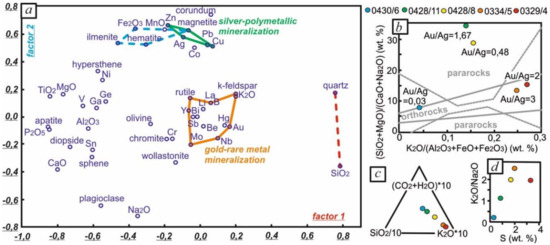
Figure 9.
Geochemical signatures of gold-bearing rocks from the Billyakh zone. (a) Results from a factor analysis of geochemical data [31]; (b–d) trends in the Au and Ag distribution in the rocks [32]. Gold samples: 0430/6, biotite plagiogneiss, tonalite (Au 0.2 ppm, Ag 6.0 ppm); 0428/11, biotite plagiogneiss, arkose (Au 1.0 ppm, Ag 0.6 ppm); 0428/8, biotite plagiogneiss, arkose (Au 1.0 ppm, Ag 2.1 ppm); 0334/5, biotite gneiss, granosyenite (Au 0.9 ppm, Ag 0.3 ppm); 0329/4, hypersthene gneiss, granosyenite (Au 1 ppm, Ag 0.5 ppm).
According to [34], mineral assemblages formed in the process of hydrothermal replacement reflect the compositional evolution of ore-forming fluid. The formation of gold mineralization commonly occurs after the peak of metamorphism and is related to multistage processes. In our case, the process of cooling the hydrothermal solution likely led, first, to the precipitation of K-feldspar, pyrite, and gold, and then quartz and silver. This process can be expressed by the following [34,35]:
NaAlSi3O8 + CaAl2Si2O8 + SiO2 + 2KOH + H2O = 2KAlSi3O8 feldspar + CaO + 0.5Na2O2 + Al(OH)3
FeCO3 + Au(HS)2− = FeS2pyrite + CO2 + OH- + 0.5H2 + Au
2Au(HS)2− + H2O + 7.5O2 = 2Au + 4SO42− + 6H+
NaAgCl2 + 0.5Na2SiO3 + 0.5H2 = Ag + 2NaCl + 0.5SiO2quartz + 0.5H2O
The factors for Figure 9 can be suggested based on the position of the figurative points of the normative quartz and corundum. The factors are related to the degree of saturation of the system with silica: factor 1 is a high degree of saturation, while factor 2 is a low degree of saturation. Potassium metasomatites were possibly formed first. The silicon metasomatites and iron–alumina metasomatites were formed later. The stages of the ore formation process were not studied.
4. Discussion
The grain size analysis of placer gold from the studied area showed that the fraction of +0.5 mm is 24%, which is typical for placers of short-range drift [4]. The discovery of a small gold nugget also signifies the proximity of the ore body. It is important to emphasize that metal finds of this size are very rare for placers in eastern Siberia, which is typically dominated by very small (−0.25 mm) gold grains, representing more than 95% [36]. Morphological features of native gold, such as a low ratio of roundness and a primary tubercular and dimpled surface, indicate its short stay in hydrodynamic environments and short-range water drift [37]. It should be noted that the studied gold of all grades was of a low roundness. Gold fineness varied from low to extremely high. We have not identified the correlation between gold fineness and size. The wide variation of gold fineness is probably due to the unstable physical and chemical environment of the ore body formation. The absence of high-grade fringes in native gold excludes its prolonged stay in exogenous environments [4,36]. This is also confirmed by the detection of a small homogeneous gold nugget with very thin and short fringes of the initial stage in the peripheral part of the polished shear (Figure 6). Admixture elements were displayed by Hg and Cu, which were identified in single grains of native gold. The small number of such grains does not allow us to conduct a thorough study.
On the basis of the above information, we can assume the presence of the nearby ore body of the studied placer gold.
According to the researchers in [3,37], mineral inclusions in gold can serve as indicators to predict placer gold ore bodies. Mineral micro-inclusions of pyrrhotite, pyrite, hessite, chalcopyrite, sphalerite, arsenopyrite, quartz, and potash feldspar were identified in the placer gold using X-ray spectroscopic microanalysis. A comparative analysis of mineral inclusions in placer gold and the ore mineral association of metasomatically altered high-potassium rocks with disseminated gold-sulfide mineralization, located in close proximity to placer manifestations, indicates that these formations may be one of the possible primary sources of the placer gold.
Due to gold mineralization having been found in the study area, the exocontact zone of the Billyakh pluton (and its associated dikes) has become the target of gold prospecting. Gold is located in the sulfidized rocks of the dike-like body, which includes chemical analogues of high-K alkali feldspar syenites that are not found in the pluton and the dikes. We attribute the origin of the highly potassic rocks to the manifestation of the intense metasomatic process of feldspathization. The K2O input was accompanied by the differentiated removal of MgO, FeOtot, CaO, TiO2, and P2O5, with SiO2, Al2O3, and Na2O showing inert behavior. It seems, however, that FeOtot was fixed—partly or completely—in the sulfides, which led to the formation of gold mineralization in high-K rocks, such as monzodiorites and quartz monzonites. Such metasomatically reworked rocks, which are analogous to syenites and alkali feldspar syenites, are the most promising in terms of the discovery of sulfides and native gold. The latter syenites, both when unaltered and slightly altered, are the most important types of rocks in the dike complex (quartz monzodiorites) and can also be found in the pluton. This suggests that finding gold-bearing rocks within the pluton is quite possible. It should be mentioned that the high-K ore-bearing rocks are characterized by a diopside–K-feldspar association, which may serve as a criterion for their discovery.
Presumably, potassic metasomatosis and sulfidization occurred in the last stages of formation of the Billyakh pluton and its associated dikes in the Early Proterozoic [14] period as a result of ore-bearing fluids reacting with the surrounding rocks.
5. Conclusions
The results from the field and laboratory studies and an analysis of the published literature and unpublished reports led us to the following conclusions:
- Detailed studies on the mineralogy of gold from placers in the areas around the Borosku Unguokhtakh and Ulakhan Khaptasynnakh creeks revealed typomorphic characteristics of placer gold with a proximal provenance. These included the poor roundness of the native gold grains, a cloddy–angular and dendritic form, an uneven pitted surface with a thin discontinuous aluminosilicate shell, and an amount of coarse-fraction native gold in the studied small-volume (1 m3) samples that was as high as 24%. Therefore, we predict that the primary source for the placer gold is located in the headwaters of the abovementioned streams;
- An in-depth study of an unrounded, low-fineness gold nugget (0.48 g) found in the area of the Billyakh TMZ further supported the presence of a nearby bedrock source;
- We studied mineral inclusions in the placer gold of the Billyakh TMZ, including pyrrhotite, pyrite, hessite, chalcopyrite, sphalerite, and arsenopyrite;
- We also investigated sulfidized rocks found around the Precambrian metamorphic rock complexes, which were chemical analogues of syenites and alkali feldspar syenites. The diopside–K-feldspar association that was common in the high-K ore-bearing rocks could serve as a criterion in the search for gold in the Anabar shield area;
- Our study of the ore mineral parageneses in the sulfidized alkali feldspar syenites—comparing them to the mineral inclusions in the placer gold—suggests that these rocks might be one of its primary sources.
Author Contributions
Conceptualization, B.G., V.B., and A.K.; methodology, B.G., V.B., and A.K.; investigation, B.G., V.B., and A.K.; writing—original draft preparation, B.G., V.B., and A.K.; writing—review and editing, B.G. and A.K.; visualization, B.G. and A.K. All authors have read and agree to the published version of the manuscript.
Funding
This work was done on state assignment from DMPGI SB RAS and as part of grant No. 18-45-140018 of the Russian Foundation for Basic Research.
Acknowledgments
The authors are grateful to the Geological Department of Almazy Anabara JSC and Chief Geologist Roman Zhelonkin for organizing field geological research.
Conflicts of Interest
The authors declare no conflicts of interest.
References
- Dill, H.G. Geogene and anthropogenic controls on the mineralogy and geochemistry of modern alluvial–(fluvial) gold placer deposits in man-made landscapes in France, Switzerland and Germany. JGE 2008, 99, 29–60. [Google Scholar] [CrossRef]
- Dill, H.G.; Steyer, G.; Weber, B. Morphological studies of PGM grains in alluvial-fluvial placer deposits from the Bayerischer Wald, SE Germany: Hollingworthite and ferroan platinum. Neues Jahrb. Mineral. Abh. 2010, 187, 101–110. [Google Scholar] [CrossRef]
- Chapman, R.J.; Mortensen, J.K.; LeBarge, W.P. Styles of lode gold mineralization contributing to the placers of the Indian River and Black Hills Creek, Yukon Territory, Canada as deduced from microchemical characterization of placer gold grains. Miner. Depos. 2011, 46, 881–903. [Google Scholar] [CrossRef]
- Nikolaeva, L.A.; Gavrilov, A.M.; Nekrasova, A.N.; Yablokova, S.V.; Shatilova, L.V. Atlas of Native Gold of Ore and Placer Deposits in Russia; Tsnigri: Moscow, Russia, 2003; p. 184. [Google Scholar]
- Alam, M.; Li, S.; Santosh, M.; Yuan, M. Morphology and chemistry of placer gold in the Bagrote and Dainter streams, northern Pakistan: Implications for provenance and exploration. Geol. J. 2019, 54, 1672–1687. [Google Scholar] [CrossRef]
- Chapman, R.J.; Mortensenb, J.K. Application of microchemical characterization of placer gold grains to exploration for epithermal gold mineralization in regions of poor exposure. JGE 2006, 91, 1–26. [Google Scholar] [CrossRef]
- Kalinin, A.A.; Savchenko, Y.E.; Selivanova, E.A. Mustard Gold in the Oleninskoe Gold Deposit, Kolmozero–Voronya Greenstone Belt, Kola Peninsula. Minerals 2019, 9, 786. [Google Scholar] [CrossRef]
- Rabkin, M.I. Geology and Petrology of the Anabar Shield; Gosgeoltekhizdat: Moscow, Russia, 1959; p. 164. (In Russian) [Google Scholar]
- Shpount, B.R. Genetic types of gold mineralization in the northeastern Siberian platform. Uch. Zap. NIIGA Reg. Geol. 1970, 18, 5–15. (In Russian) [Google Scholar]
- Levin, V.I.; Permyakov, E.D. Gold mineralization in the rocks of the Mukun Formation in the Malaya Kuonamka-Biriginde RR. interfluve (Anabar shield). Geol. Geoph. 1973, 5, 49–56. (In Russian) [Google Scholar]
- Tolstov, A.V. Gold potential of the Anabar anteclise. Vestn. Goskomgeol. 2002, 1, 44–49. (In Russian) [Google Scholar]
- Tolstov, A.V. Regularities in the Origin and Distribution of the Main Ore-Bearing Formations in the Northern Siberian Platform. Ph.D. Thesis, DPMGI SB RAS, Yakutsk, Russia, 2006. (In Russian). [Google Scholar]
- Dodin, D.A. Metallogeny of the Taimyr-Noril’sk Region; Nauka: St. Peterburg, Russia, 2002; p. 822. (In Russian) [Google Scholar]
- Smelov, A.P.; Amuzinsky, V.A.; Zedgenizov, A.N.; Beryozkin, V.I.; Koval, S.G. Potential primary gold mineralization in metamorphic and magmatic complexes of the Anabar shield. In Proceedings of the Third All Russia Symposium “Gold of Siberia and the Far East”, Ulan-Ude, Russia, 21–25 September 2004; pp. 279–281. (In Russian). [Google Scholar]
- Kuznetsov, A.A. Geologic-prediction-mineragenic model and prospects for commercial mineralization of the Anabar shield. Dom. Geol. 2008, 6, 22–34. (In Russian) [Google Scholar]
- Ehrig, K.; Mcphie, J.; Kamenetsky, V. Geology and Mineralogical Zonation of the Olympic Dam Iron Oxide Cu-U-Au-Ag Deposit, South Australia. Soc. Econ. Geol. Inc. Spec. Pub. 2012, 16, 237–267. [Google Scholar]
- Molchanov, A.V.; Tolstov, A.V.; Efimov, S.A. Uranium metallogeny of ancient shields. In Proceedings of the Regional Scientific-Practical Conference “Topical Problems of the Geologic Branch of ALROSA Co. and Scientific-Methodic Provision for their Solution”, Mirny, Russia, 15–18 March 2003; pp. 666–675. (In Russian). [Google Scholar]
- Luts, B.G.; Oxman, V.S. Deeply Eroded Fault Zones of the Anabar Shield; Nauka: Moscow, Russia, 1990; p. 260. (In Russian) [Google Scholar]
- Rosen, O.M.; Zhuravlev, D.Z.; Sukhanov, M.K. Isotopic-geochemical and age characteristics of the Early Proterozoic terranes, collisional zones and the associated anorthosites in the northeast of the Siberian craton. Geol. Geoph. 2000, 41, 163–180. (In Russian) [Google Scholar]
- Lopatin, B.G. Geological Map of the USSR at a Scale of 1:200000. The Anabar Series. Sheets R-49-XV, XVI. Explanatory Note; Nedra: Moscow, Russia, 1972; p. 81. (In Russian) [Google Scholar]
- Siivola, J.; Schmid, R.A. Systematic Nomenclature for Metamorphic Rocks: 12. List of Mineral Abbreviations. Recommendations by the IUGS Subcommission on the Systematics of Metamorphic Rocks. Recommendations, Web Version of 01.02.2007; The International Union of Geological Sciences: Beijing, China, 2007. [Google Scholar]
- Whitney, D.L.; Evans, B.W. Abbreviations for names of rock-forming minerals. Am. Mineral. 2010, 95, 185–187. [Google Scholar] [CrossRef]
- Smelov, A.P.; Kotov, A.B.; Sal’nikova, E.B.; Kovach, V.P.; Beryozkin, V.I.; Kravchenko, A.A.; Dobretsov, V.N.; Velikoslavinskii, S.D.; Yakovleva, S.Z. Age and duration of the formation of the Billyakh tectonic melange zone, Anabar Shield. Petrology 2012, 20, 286–300. [Google Scholar] [CrossRef]
- Rosen, O.M.; Turkina, O.M. The Oldest Rocks Assemblages of the Siberian Craton. Earth’s Oldest Rocks; Van Kranendonk, M.J., Smithies, R.H., Bennett, V.C., Eds.; Elsevier: Amsterdam, The Netherlands, 2007; pp. 793–838. [Google Scholar]
- Gladkochub, D.P.; Donskaya, T.V.; Ernst, R.; Mazukabzov, A.M.; Sklyarov, E.V.; Pisarevsky, S.A.; Wingate, M.; Suderlund, U. Proterozoic mafic magmatism in Siberian craton: An overview and implications for paleocontinental reconstruction. Precambrian Res. 2010, 183, 660–668. [Google Scholar] [CrossRef]
- Shatsky, V.S.; Malkovets, V.G.; Belousova, E.A.; Tretiakova, I.G.; Griffin, W.L.; Ragozin, A.L.; Gibsher, A.A.; O’Reilly, S.Y. Tectonothermal evolution of the continental crust beneath the Yakutian diamondiferous province (Siberian craton): U–Pb and Hf isotopic evidence on zircons from crustal xenoliths of kimberlite pipes. Precambrian Res. 2016, 282, 1–20. [Google Scholar] [CrossRef]
- Patchett, J.; Kouvo, O. Origin of continental crust of 1.9-1.7 Ga age: Nd isotopes and U-Pb zircon ages in the Svecokarelian terrain of South Finland. Contrib. Mineral. Petrol. 1986, 92, 1–12. [Google Scholar] [CrossRef]
- Gaal, G.; Sundblad, K. Metallogeny of gold in the Fennoscandian Shield. Miner. Depos. 1990, 25, 104–114. [Google Scholar] [CrossRef]
- Kulikov, Y.P. Explanatory Note. State Geological Map of the USSR. Scale 1:200 000; Series of the Anabar Shield R-48-XI, XII; R-49-I, II; R-49-VII, VIII; R-49-XIII, XIV; VSEGEI (Russian Geological Research Institute VSEGEI): Moscow, Russia, 1987; p. 87. [Google Scholar]
- Istomin, V.A.; Shakhotko, L.I.; Shcherbakova, I.P. Geological and Minerogenic Mapping. Scale 1:200000; Sheets R49-XVII, XXI, XXII, XXVII, XXVIII. Group №15. Report for the 1988-1992 years; Aerogeologia (State Research and Production Enterprise “Aerogeologia”): Moscow, Russia, 1992; p. 297. [Google Scholar]
- Kravchenko, A.A.; Gerasimov, B.B.; Beryozkin, V.I.; Mukhamedyarov, M.G.; Rassokhin, V.V.; Kardashevskaya, V.N. Prerequisites for a search for gold deposits in metamorphic complexes of the Arctic zone of the Sakha Republic (Yakutia) (Anabar shield and Olenek uplift). Vestn. SVFU Ser. Earth Sci. 2018, 4, 5–13. (In Russian) [Google Scholar]
- Kravchenko, A.A.; Gerasimov, B.B.; Beryozkin, V.I.; Sharina, A.K.; Zhelonkin, R.Yu. Distribution of gold and silver in the rocks of the Khaptasynnakh ore zone (Anabar shield). Vestn. SVFU Ser. Earth Sci. 2019, 4, 31–40. (In Russian) [Google Scholar]
- Lindgren, W. Mineral Deposits; McGraw-Hill Book Company, Inc.: New York, NY, USA, 1933; p. 930. [Google Scholar]
- Zhu, Y.; An, F.; Tan, J. Geochemistry of hydrothermal gold deposits: A review. Geos. Front. 2011, 2, 367–374. [Google Scholar] [CrossRef]
- Yin, Y.; Zajacz, Z. The solubility of silver in magmatic fluids: Implications for silver transfer to the magmatic-hydrothermal ore-forming environment. Geochim. Cosmochim. A 2018, 238, 235–251. [Google Scholar] [CrossRef]
- Nikiforova, Z.S.; Gerasimov, B.B.; Glushkova, E.G.; Kazhenkina, A.G. Indicative features of placer gold for the prediction of the formation types of gold deposits (east of the Siberian Platform). Russ. Geol. Geophys. 2018, 59, 1318–1329. [Google Scholar] [CrossRef]
- Moles, N.R.; Chapman, R.J. Integration of Detrital Gold Microchemistry, Heavy Mineral Distribution, and Sediment Geochemistry to Clarify Regional Metallogeny in Glaciated Terrains: Application in the Caledonides of Southeast Ireland. Econ. Geol. 2019, 114, 207–232. [Google Scholar] [CrossRef]
© 2020 by the authors. Licensee MDPI, Basel, Switzerland. This article is an open access article distributed under the terms and conditions of the Creative Commons Attribution (CC BY) license (http://creativecommons.org/licenses/by/4.0/).